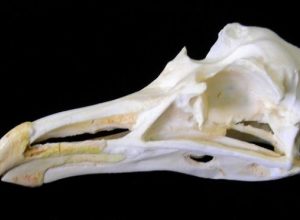L. californicis Skull Replica or California Gull measures 4.9 inches. California Gull Skull Replica is museum quality polyurethane cast. Made in USA.
L. californicis Skull Replica or California Gull measures 4.9 inches. California Gull Skull Replica is museum quality polyurethane cast. Made in USA.
The L. californicis or California gull (Larus californicus) is a medium-sized gull, smaller on average than the herring gull, but larger on average than the ring-billed gull.
It lives not just in California, but up and down the entire Western coast of North America, and has breeding ground inland. The yellow bill has a black ring.
Their breeding habitat is lakes and marshes in interior western North America from the Northwest Territories, Canada south to eastern California and Colorado.
They nest in colonies, sometimes with other birds. The nest is a shallow depression on the ground lined with vegetation and feathers. The female usually lays 2 or 3 eggs. Both parents take turns feeding their chicks.
They are migratory, most moving to the Pacific coast in winter. It is only then that this bird is regularly found in western California.
These birds forage in flight or pick up objects while swimming, walking or wading. They mainly eat insects, fish and the eggs and young of other birds, especially ducklings.
Opportunistic feeders, they also scavenge at garbage dumps, marinas and docks. They frequently beg for food at public beaches, parks and other locations where people will hand feed them. They have been known to steal food directly from people at picnics and outdoor restaurants.
L. californicis or California gulls are also known to eat various vegetables and fruits, particularly cherries. As a result, it may be regarded as a crop pest.
This is the state bird of Utah, remembered for assisting Mormon settlers in dealing with a plague of Mormon crickets. A monument in Salt Lake City commemorates this event, known as the “Miracle of the Gulls”.
In California, the L. californicis or California gull recently held the protected status California Species of Special Concern due to declining numbers at their historic California breeding colony at Mono Lake.
In recent decades this species has begun to breed in the southern portion of San Francisco Bay, where it did not historically breed, and has undergone exponential population growth.

